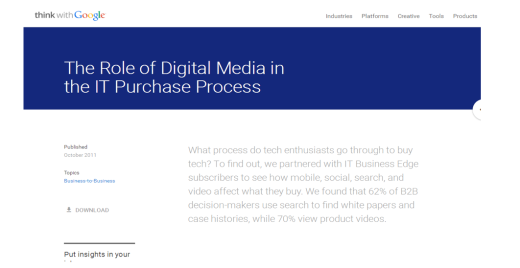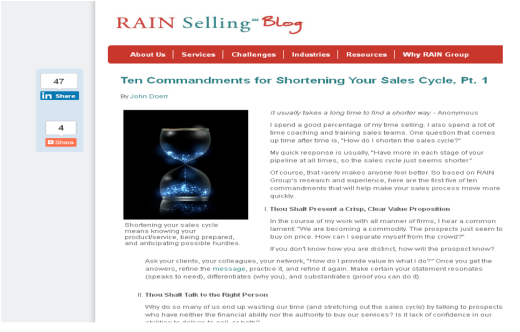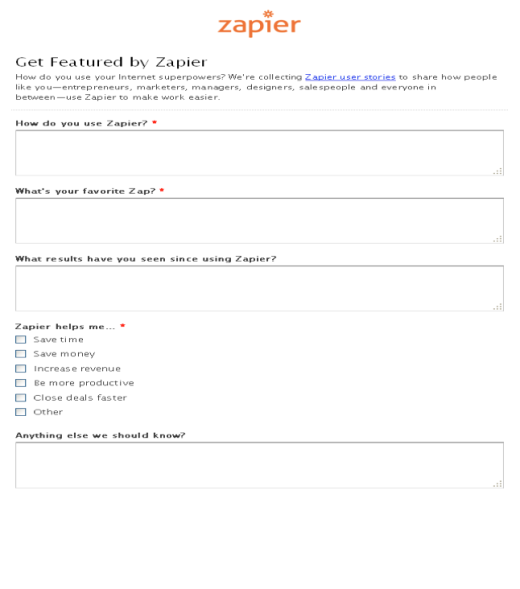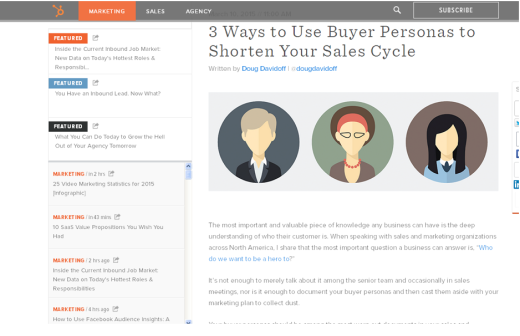
Unless you have the good fortune to have been introduced through a referral, your buyer has a long list of reasons not to buy.
“As you are selling,” he is asking himself, “Can you do what you say you can?”, “Do you really understand my company and what I am facing?”, and “Will I get the return on my investment in your fees?” says John Doerr of the RAIN Group.
Sometimes, the main reason we search Google before we make a purchase decision is to see if people have already had success using the product we’re about to buy.
In fact, Google has found [that] “64 percent of IT B2B decision makers use search engines to find white papers/case histories in preparation for their purchase.”

Well, that’s simply because there is a pretty huge difference between mere promises and tangible results. Every startup promises to solve a specific problem for people; which mostly always sound exciting. But then, nothing persuades us better to buy anything than when we’re certain it works, right?
This is where customer stories (aka case studies, customer stories, success stories) come in. They simply show how our products work, just like it does for others.
However, just like anything in life, there are right and wrong ways to writing these stories. The following few tips will help you create case studies that score sales:
Feature customers from various niches
Most clients aren’t just interested in knowing if your product works. They also want to know if it would work for their kind of business. John puts it this way:
“Provide stories, case studies, and demonstrable examples of how you have helped similar companies. Don’t talk about how good you are, show it.”

Simply, here’s what you should do: go through your list of existing clients and see the various industries they all came from. Feature at least one client from each industry.
Do more of written case studies than other formats
Eccolo Media surveyed over 500 tech purchasing decision makers and influencers for its seventh annual report and found that buyers overwhelmingly prefer traditional written case studies to those in audio, video, one-page summaries or PowerPoint formats.
These formats (video, audio, etc) are really great. However, if you’d like to get on the good side of most of your prospects, it’s better you provide your stories in the format they mostly prefer written case studies.
Feature customers with eye-catching stories
Not all customers have great experiences with your product that can be used to create eye-catching stories. Some just have stories; not ones that catches the eyes of your prospects.
Here are a few things you should look out for to get customers with eye-catching stories (these questions would depend on your sales and marketing goals, however):
- Which of your products did they use?
- How did they use it?
- What results have they experienced?
- How long have they been your customer?
- Would they be interested in participating in this case study?
- If yes, who’s the best person in their company you should interview for it?
For example, Zapier sends out an automated e-mail every Wednesday to ask some of their customers to participate in their case studies. They simply ask them to fill out a short form that covers the main points that shows if a customer’s story would be worth paying attention to.

Ask the right questions in your interviews
Once you know the best customers to feature, the next thing you (or your writer) want to make sure of is to ask the right questions when interviewing your customers. Questions like…
- What experience were they trying to change with your product?
- Have they tried any other product before applying your product
- What was the experience like?
- How did they find your product?
- When they found it, how did they use it and what was the solution it provided?
- What other info would they like to share in the story?
- Is there anything they wouldn’t want to see in the post?
Get stories on each of your products
Your stories will work better if they cover the various products you sell. We (humans) tend to relate well with the people or things we’re familiar with. So if you sell products X, Y and Z, you should have case studies on each of them. If a prospect is interested in product Y, he’d mostly prefer to see a story about it in action.
Use SlideShare to benefit from SEO
Google indexes every presentation on SlideShare. Besides, the site gets over 60 million monthly visitors. You can benefit a lot from this by doing SlideShare presentations of your stories.
What to do when customers refuse your case study requests
One challenge that many businesses face when trying to get their case studies done is getting customers to agree to participate.
Some customers may have a number of reasons why they wouldn’t want to get featured in your case studies. Here are a few tips you can employ to earn their interest:
1. Present the case study request as a win-win situation
“Let your customers know what’s in it for them”. That’s what most experts would tell you. And they’re correct. But more importantly, propose your request as a win-win situation where you don’t sound like customers are doing you a favor if they decide to participate. Present the story as a marketing content that both you and the company would gain from. Tell them how you’d be distributing the stories and what exposure they would be getting.
2. Allow someone familiar to the customer make the request
Just like I mentioned earlier, people tend to respond better to people/things they are familiar with. If your sales rep is the person familiar with the contact, let him or her make the request.
3. Offer discounts for customers who agree to participate
“Participate in this case study and earn a discount of $200 or 30 percent” can mean a lot to a customer. After all, the case study will cost nothing but an hour or two.
4. Let customers know you won’t be taking too much time
Some customers are just too busy. They only have time for the biggest opportunities around. So let them know how much of their time you would be taking for the interview. Typically, this should not be more than 1hr.
Two added benefits of customer stories
I mentioned earlier that [according to Google] 64 percent of IT B2B decision makers use search engines to find white papers/case histories in preparation for their purchase.
This implies that customer stories simply shorten the sales cycle.
However, apart from this major benefit, there are two other crucial benefits that case studies provide:
1. You get to know your customers better
One crucial benefit you also get from case studies is quality insights into your buyer personas. You get to better understand why your customers behave the way they do and position your company/product in such a way that suits their needs better.
“The most important and valuable piece of knowledge any business can have is the deep understanding of who their customer is,” says Doug Davidoff writer at HubSpot.

“…it is impossible to have alignment with clarity on who you are trying to attract without defining your buyer personas. Service level agreements are wonderful, but buyer personas are at the center of alignment.” Doug added.
When you ask questions that tackle specific pain points, problems, or needs of each featured customer, you don’t only get an interesting customer story; you also get quality insights about your customers and prospects.
-
Stories make guest blogging campaigns more effective
Guest blogging is a marketing strategy that has taken a lot of businesses from zero to several figures of income; including mine.
Simply put when done rightly, guest blogging just works.
Last year, Ayodeji Onibalusi asked 30 online marketing experts what role they think guest posting will play in 2015? How is it going to fit into companies content strategy?

While every featured expert (like Neil Patel, Rand Fishkin, Sujan Patel, etc) dropped their candid and valid opinions, Harsh Agarwal explained how the power of storytelling can be used for effective guest posting:
“Companies should focus more on storytelling because that is one thing that will work best with their guest posting campaign. Storytelling could be in the form of case-study, journey of the company or anything which touches the reader emotionally.”
What interesting stories are your customers experiencing in your company? Share them as guest posts (without being too promotional, though). They simply work better than hard facts and figures.
In conclusion…
“Stories are a shared experience, and I believe we are hard-wired to receive information primarily through storytelling.” says Forbes contributor Rodger Dean Duncan.
Customer stories can really enhance your sales, marketing and PR. However, the results you end up earning from them depends on how you go about creating and using them.
Read Next: Why infographics are the secret to super SEO
Image credit: Shutterstock
Get the TNW newsletter
Get the most important tech news in your inbox each week.




